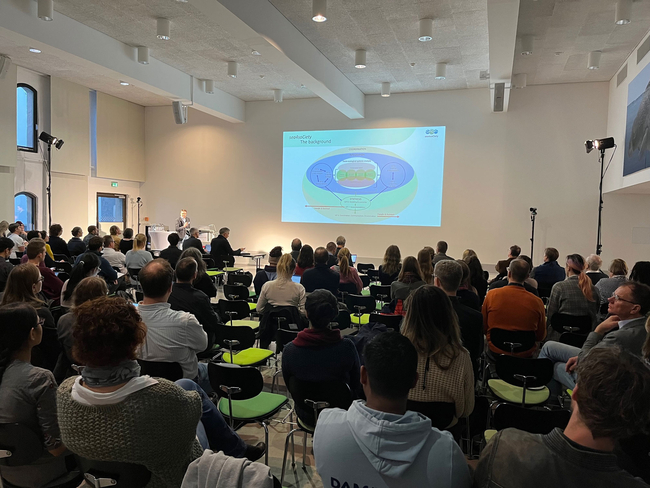Time is of the essence: Worldwide, research is warning that it will soon be impossible to curb man-made climate change to a point where the internationally agreed climate targets can be met. According to current knowledge, even a drastic reduction in carbon dioxide (CO2) emissions implemented immediately is no longer sufficient, but will have to be supplemented by additional removal of CO2 from the atmosphere. This is the background for the 2nd annual conference of the research mission CDRmare of the German Marine Research Alliance (DAM) in Stralsund. About 200 experts will discuss ocean-based methods of atmospheric CO2 removal for three days. Within the framework of CDRmare, the Leibniz Centre for Tropical Marine Research (ZMT) coordinates the joint project sea4soCiety. From ZMT Martin Zimmer, Theresa Fett, Mondane Fouqueray, Véronique Helfer, Alexandra Nozik und Mirco Wölfelschneider are among the participants. They are joined by Nils Moosdorf who is part of the CDRmare project RETAKE.
The research mission CDRmare – short for “Marine carbon sinks in decarbonisation pathways” (CDR stands for Carbon Dioxide Removal) – is funded by Germany’s Federal Ministry of Education and Research (BMBF) for currently three years with about 26 million euros and merges the expertise of a total of 22 research institutions, governmental agencies and companies. Coordinated at the GEOMAR Helmholtz Centre for Ocean Research Kiel and the Leibniz Institute for Baltic Sea Research Warnemünde (IOW), about 200 scientists in six research consortia have been working since August 2021 on different methods of increasing the ocean’s potential to absorb CO2 from the atmosphere and storing it. Risks and possible impacts of such methods on the marine environment and the Earth system, as well as the societal, ethical and legal aspects of such measures, are also being researched.
During the second annual CDRmare meeting at the Stralsund Ozeaneum, the research results achieved since the beginning of the mission will be discussed. Specifically, the focus is on the following approaches to ocean-based CO2 removal from the atmosphere: 1. Increasing the alkalinity of seawater – e.g., by introducing rock powder – is expected to enhance the ocean’s CO2 uptake from the atmosphere. 2. Artificially generated upwelling of deep, nutrient-rich water in certain ocean areas is expected to increase the binding of atmospheric CO2 in algal biomass. 3. The carbon storage potential in vegetation-rich coastal ecosystems, especially seagrass beds, salt marshes, and mangroves, needs be enhanced systematically. 4. The feasibility and overall conditions for CO2 storage under the seabed are explored for areas that have not yet been used for this purpose. The spectrum of CDRmare’s research approaches ranges from lab studies to mesocosm studies in natural ecosystems and investigations in tropical mangrove forests to regional and global modelling.
On the occasion of the Stralsund CDRmare meeting, Federal Research Minister Bettina Stark-Watzinger explains: “To decisively combat climate change, we must also rely on technologies for removing CO2 from the atmosphere and storing it. This is also emphasised by the Intergovernmental Panel on Climate Change (IPCC) in its latest reports. We must allow the storage of CO2 on an industrial scale in the short term to move quickly into implementation. The necessary change in the law must allow further research, as without it Germany as a science location would fall behind in this field. The Federal Ministry of Education and Research has already supported research into this future-oriented topic at an early stage. With a total of around 50 million euros, we are supporting research into land-based and marine CO2 removal methods, such as with CDRmare, so that Germany can play a pioneering role in the future. Now it’s a matter of laying the technological and regulatory foundations promptly.”
“The ocean is already a major player in climate change mitigation, absorbing about a quarter of man-made CO2 emissions each year and thus slowing global warming. Given that by mid-century, even with massive emissions reductions, humanity will likely still be discharging 5 to 15% of today’s CO2 emissions, it is immensely important to explore all options that can counteract these residual emissions by removing CO2 from the atmosphere and achieve net zero emissions. The ocean can play an important role in this. We are investigating how this role can be in agreement with marine conservation and climate protection,” CDRmare co-spokesperson Andreas Oschlies, oceanographer and climate modeller at GEOMAR, commented at the conference kick-off. “It is important to us that the results of CDRmare provide viable options for action, on the basis of which the necessary decisions can be made in politics, economy and society. It is also important to investigate possible environmental risks, conflicts of use and distributional injustice. That’s why we conduct our research in close dialogue with the respective societal stakeholders and are therefore pleased that some of the relevant actors are present here at the conference,” adds Gregor Rehder, IOW marine chemist and also co-spokesperson of CDRmare.
Both CDRmare spokespersons agree that the research mission can report a positive mid-term result for the first funding phase: All research consortia have successfully and efficiently embarked into practical work – involving a wide variety of laboratory investigations, mesocosm experiments, sea voyages and near-shore sampling campaigns in Germany and abroad, as well as technology development for eventual monitoring and initial modelling studies to extrapolate results to larger ocean areas. “The overall networking of the CDRmare researchers and the cross-institutional data management, both immensely important for such a large-scale research mission with so many institutional partners, are well established by now. Furthermore, knowledge transfer with policy makers and society has already begun, for example with the creation of fact sheets on the various ocean-based CDR approaches and dialogue events specifically for policy makers and the interested public,” Oschlies and Rehder sum up the concerted effort.
In addition to the in-depth discussion of the mission’s achievements to date, the conference will also provide the opportunity to further advance research planning within the CDRmare framework, particularly with regard to the second funding period, which is planned to begin in the summer of 2024.





